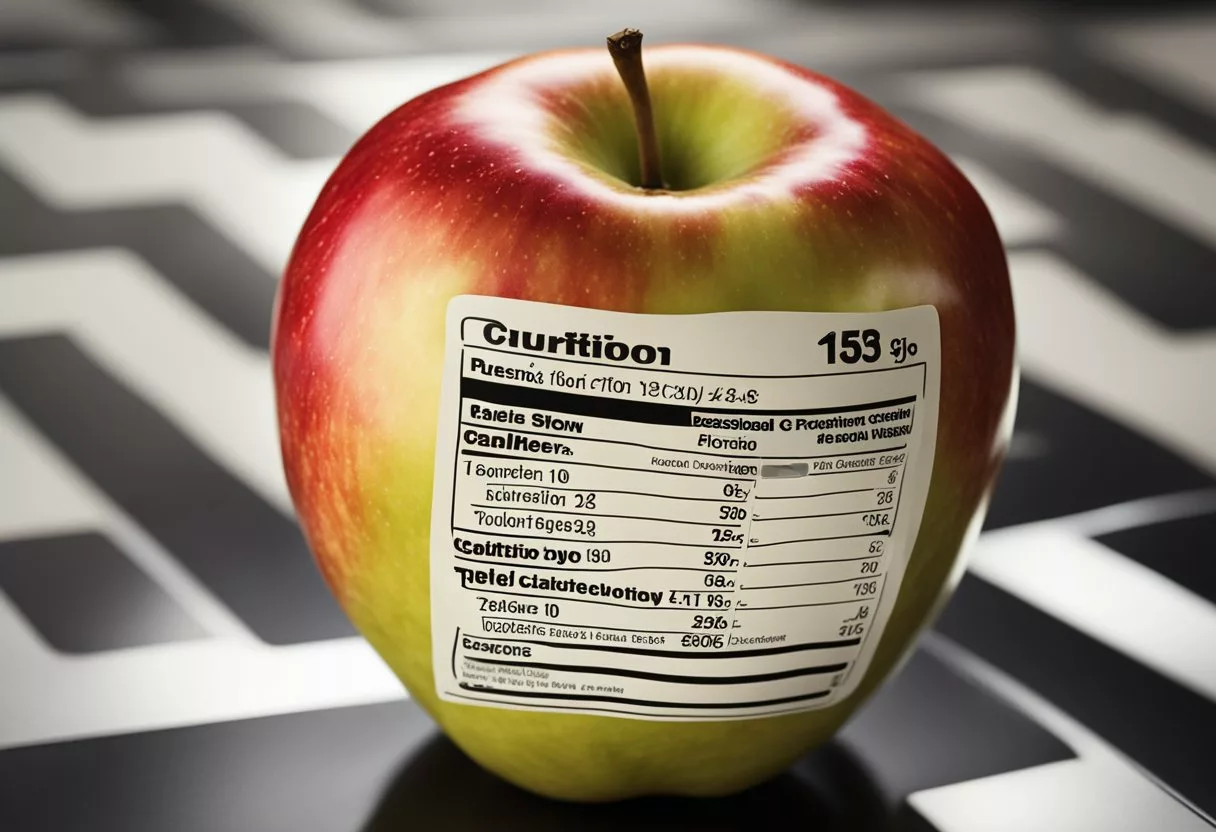When considering the nutritional value of everyday foods, apples often stand out. A medium apple with the skin offers about 95 calories, making it a low-calorie snack option. Aside from being low in calories, apples are packed with vital nutrients like fiber, vitamin C, and potassium.

Apples are more than just a tasty fruit. They play a crucial role in a balanced diet by providing dietary fiber, which helps in digestion. Their content of antioxidants and phytochemicals can contribute to better heart health and lower the risk of certain diseases.
Incorporating apples into daily meals is simple due to their versatility. Whether eaten raw, added to salads, or baked into desserts, they bring a healthy and tasty option to any meal plan. Compared to other fruits, apples hold their own with their unique health benefits and nutritional profile.
Key Takeaways
- A medium apple has about 95 calories.
- Apples provide fiber, vitamin C, and potassium.
- Apples can contribute to heart health and lower disease risk.
Nutritional Profile of Apples
Apples are a popular fruit that provides many health benefits. They are low in calories yet high in important nutrients like fiber, vitamins, and minerals.
Calories and Serving Sizes
One medium-sized apple, weighing around 200 grams, contains approximately 104 calories. Serving sizes can vary, but a medium apple is common. Even a small apple, about 150 grams, offers roughly 77 calories. Most of these calories come from carbohydrates, specifically natural sugars and fiber.
Macronutrients
Macronutrients in apples include carbohydrates, protein, and fat. A medium apple contains about:
- Total Carbohydrates: 25-27 grams
- Fiber: 4-5 grams
- Sugar: 19 grams (naturally occurring)
- Protein: 0.5 grams
- Total Fat: Less than 1 gram
- Polyunsaturated Fat: Negligible
- Monounsaturated Fat: Negligible
Apples are primarily a source of carbs, with very minimal fat and protein.
Vitamins and Minerals
Apples are a good source of several important vitamins and minerals[1]. They contain:
- Vitamin C: Helps with immune function and skin health.
- Potassium: Supports heart health and muscle function.
- Phytochemicals: Quercetin, catechin, and chlorogenic acid, which have antioxidant properties.
Even though they have low fat content, apples are rich in essential nutrients. Eating them can contribute significantly to one’s daily nutrient intake.
Health Benefits of Apples

Eating apples offers a range of health benefits due to their rich nutritional content. These benefits include better digestive health, effective weight management, and disease prevention.
Dietary Fiber and Digestive Health
Apples are high in dietary fiber, specifically soluble fiber like pectin. This type of fiber aids digestion and helps to prevent constipation. Eating apples with their skin provides additional insoluble fiber, which adds bulk to stool and promotes regular bowel movements.
Fruits like apples are also beneficial for managing conditions like irritable bowel syndrome (IBS) due to their fiber content. However, individuals with fructose intolerance should be cautious as apples contain fructose. Regular consumption of fiber-rich fruits can also help reduce inflammation and improve long-term gut health.
Sugar Content and Diabetes Management
While apples contain sugars such as fructose, sucrose, and glucose, they have a low glycemic index. This means they do not cause significant spikes in blood sugar levels. The fiber in apples slows down the absorption of sugars, making them a better option for those managing diabetes.
Studies suggest that regularly eating apples can help lower the risk of developing type 2 diabetes. The natural sugars in apples also make them a healthy sweet treat, reducing the need for processed snacks. The antioxidants found in apples like quercetin may also reduce the risk of heart disease.
Fat Content and Weight Management
Apples are low in calories and contain almost no fat, making them an excellent choice for weight management. The high-water content in apples helps to make one feel full, reducing the likelihood of overeating.
The soluble fiber in apples, such as pectin, aids in making one feel satisfied after eating. This can help in reducing overall calorie intake. Including apples in a balanced diet can be an effective strategy for weight loss and maintaining a healthy weight.
Vitamins, Minerals, and Disease Prevention
Apples are rich in vitamin C, an important antioxidant that helps protect cells from damage. This can slow down aging and reduce the risk of chronic diseases such as heart disease and certain types of cancer. Eating apples with the skin increases the intake of these beneficial nutrients.
The fruit also provides essential minerals like potassium, which helps regulate blood pressure. Regular consumption of apples has been linked to improved heart health and a lower risk of stroke. The antioxidants in apples, including quercetin, have anti-inflammatory properties that strengthen the immune system and may help prevent diseases like breast cancer.
Culinary Uses of Apples

Apples are a versatile fruit used in a variety of dishes, from sweet desserts to savory meals. This section will guide you through selecting the right apple varieties, preparing them for cooking, and exploring some delicious apple-based recipes.
Apple Varieties and Selection
Choosing the right apple variety can greatly impact your dish. Red Delicious apples are ideal for fresh eating due to their mild flavor and crisp texture. For baking, Granny Smith apples are preferred because of their tartness and firm structure, which holds up well when cooked.
When making desserts like apple pie or apple crisp, a blend of apples can provide a balance of sweetness and acidity. Honeycrisp and Fuji apples are great for salads and snacks because of their juicy and sweet flavors.
Preparing Apples for Recipes
Before using apples in recipes, proper preparation is key. Start by washing the apples thoroughly to remove any pesticides or wax. Peel the apples if the recipe calls for it or if you prefer a smoother texture. Using a corer can make the task easier and quicker.
Slice or dice the apples based on your recipe needs. For baked goods, uniform pieces ensure even cooking. To prevent browning, sprinkle cut apples with a bit of lemon juice. This step is important for keeping the apple pieces looking fresh, especially in salads.
Apple-Inspired Recipes and Meals
Apples can be featured in various types of dishes. For breakfast, try an apple oatmeal where the fruit adds natural sugar and fiber. As a snack, apple slices with peanut butter offer a nutritious option rich in protein and vitamin A.
For side dishes, apple slaw combines apples with cabbage, providing a crunchy and refreshing flavor. When it comes to main courses, pork chops with apples and onions create a savory and slightly sweet meal enriched with potassium and vitamin C. In desserts, apple crisp and apple pie are classics that balance sweetness with the fruit’s natural tartness. For a healthier dessert, baked apples with a sprinkle of cinnamon can be a comforting yet nutritious choice.
Comparison to Other Fruits

Different fruits offer various vitamins and nutrients. Below, apples are compared to other common fruits in terms of calories and nutritional content. Apples, bananas, and oranges will be the primary focus.
Apples vs. Other Common Fruits
Apples contain about 104 calories in a medium-sized fruit. They also provide 0.5 grams of protein, and 27.6 grams of carbohydrates, including 19 grams of sugars. Their fiber content is notable, aiding in digestion and weight management.
Bananas have around 105 calories per medium fruit. They are rich in potassium and provide about 1.3 grams of protein. Bananas offer 27 grams of carbohydrates and 14 grams of sugars. They also contain vitamin B6, magnesium, and folate, important for cell function and energy production.
Oranges have about 62 calories per medium fruit and are famous for their high vitamin C content. They contain 1.2 grams of protein and 15.4 grams of carbohydrates, with 12 grams of sugars. Oranges also provide fiber, which helps in lowering cholesterol and preventing heart disease.
Nutrient Comparison Table
| Fruit | Calories | Protein (g) | Carbs (g) | Sugars (g) | Fiber (g) | Key Vitamins |
|---|---|---|---|---|---|---|
| Apple | 104 | 0.5 | 27.6 | 19 | 4.8 | Vitamin C, K |
| Banana | 105 | 1.3 | 27 | 14 | 3.1 | Vitamin B6, Folate |
| Orange | 62 | 1.2 | 15.4 | 12 | 3.1 | Vitamin C |
Caloric and Nutritional Differences
Apples, bananas, and oranges vary significantly in caloric and nutritional content. Apples provide moderate calories and high fiber, crucial for digestive health. They also supply small amounts of vitamins C and K, beneficial for immune function and blood clotting.
Bananas, on the other hand, have nearly the same calories as apples but are richer in potassium. This makes them good for heart health. They also offer vitamin B6 and folate, key in energy metabolism.
Oranges are the lowest in calories among the three. Their high vitamin C content supports the immune system and skin health. Oranges also provide fiber and low desertions of potassium, magnesium, and calcium, contributing to overall health.
Nutritional Highlights
- Apples: High in fiber, moderate calories, vitamin C, K.
- Bananas: Potassium-rich, moderate calories, vitamin B6, folate.
- Oranges: Low calories, high vitamin C, fiber.
Each fruit has unique benefits making them valuable additions to a balanced diet.
Nutrition Advice and Guidelines
Understanding how to incorporate apples into a balanced diet is key. This section provides important guidelines to help manage daily nutritional needs, appropriate fruit intake, and when to seek advice from nutrition experts.
Daily Nutritional Requirements
Daily nutritional requirements vary based on age, gender, and activity level. A balanced diet contains essential nutrients such as Vitamin A, Vitamin C, potassium, calcium, and iron.
For instance, potassium helps maintain heart health, and iron supports red blood cell production. Apples provide dietary fiber and Vitamin C, both of which contribute to general nutrition advice that emphasizes maintaining a nutrient-rich diet.
Governments often advise consuming around 2,000 calories per day for adults. An apple, being low in calories and rich in fiber, fits well into this plan. Including apples in your diet can help meet the fiber and vitamin requirements set out by nutrition guidelines.
Recommendations for Fruit Intake
Fruits are essential for a balanced diet due to their vitamins, minerals, and fiber content. The USDA recommends consuming at least 1.5 to 2 cups of fruit daily for adults.
Apples can be an easy way to reach this goal. One medium apple offers about 4 grams of dietary fiber, which supports digestive health.
Including a variety of fruits ensures that you receive a range of nutrients. Mixing apples with other fruits like berries, bananas, and oranges can diversify your nutrient intake.
Consulting Nutrition Experts
For personalized nutrition advice, consulting a registered dietitian can be beneficial. They tailor dietary recommendations based on individual health needs, lifestyle, and preferences. Dietitians can provide specific advice on how to incorporate apples and other fruits into your daily diet.
If you have health conditions like diabetes or are on a restrictive diet, expert guidance becomes even more crucial. Nutrition experts can help balance your diet to ensure you receive ample Vitamin D, Vitamin C, fiber, and other essential nutrients without exceeding calorie goals.
Seeking help from professionals ensures that your diet supports your health goals and adheres to recommended daily values for nutrients. It empowers you to make informed choices about your nutrition.
Understanding Food Labels

Understanding food labels is essential for making healthier dietary choices. This section covers the crucial aspects of nutrition facts labels, including how to identify added sugars and fats.
Deciphering Nutrition Facts Labels
Nutrition facts labels provide valuable information about the food’s nutritional content. They include details on calories, fats, sugar, protein, vitamins, and minerals.
The label starts with the serving size, which indicates the amount of the food people typically eat in one sitting. It also lists the number of calories per serving. Knowing the serving size helps to understand the rest of the information.
Next is the list of nutrients, including total fat, saturated fat, trans fat, cholesterol, sodium, total carbohydrate, dietary fiber, total sugars, and added sugars. Each nutrient shows the amount per serving and its percentage of the daily value (DV). The DV helps to gauge how much of each nutrient one should consume daily.
Identifying Added Sugars and Fats
Added sugars and fats are critical components to look for on food labels. These can significantly impact overall health.
Total Sugars include both natural and added sugars. It’s important to distinguish between them. Natural sugars are found in fruits and milk, while added sugars are included during processing. Added sugars are listed separately to help consumers limit their intake. They are found in many processed foods and can lead to health issues like obesity and diabetes.
Fats are divided into total fat, saturated fat, and trans-fat. Total fat includes all types of fats in the food. Saturated fats and trans fats can raise cholesterol levels and increase heart disease risk. It’s crucial to monitor these closely. Choosing foods with healthier fats, like monounsaturated and polyunsaturated fats, is beneficial.
Understanding these components can greatly assist in making healthier food choices.
Health Considerations

Eating apples can offer several health benefits, but there are important considerations regarding allergies, blood sugar levels, and heart health.
Apple Consumption and Allergies
Some people may experience allergic reactions when consuming apples. This is often due to a condition known as oral allergy syndrome. Symptoms can include itching or swelling of the mouth, lips, and throat. People who are allergic to birch pollen are more likely to react to apples due to similar proteins. Cooking or peeling apples may reduce these reactions. It is important for individuals with known allergies to consult with their healthcare provider before introducing apples into their diet.
Impact on Blood Sugar and Diabetes
Apples have a moderate glycemic index, meaning they can have a significant impact on blood sugar levels. The fiber in apples can help slow the absorption of sugar, which can benefit those with diabetes. A medium apple contains about 25 grams of carbohydrates, with about 19 grams coming from sugar. Despite the natural sugars, apples can be part of a balanced diet for diabetics when consumed in moderation. People with diabetes should monitor their blood sugar levels and discuss dietary choices with their healthcare provider.
Influence on Heart Health and Cholesterol
Apples are rich in fiber and antioxidants, which can positively impact heart health. Eating apples regularly has been associated with a reduced risk of cardiovascular diseases. The soluble fiber, particularly pectin, helps lower LDL (“bad”) cholesterol levels. Additionally, apples contain flavonoids and polyphenols that improve blood vessel function and reduce inflammation. Consuming apples as part of a heart-healthy diet can contribute to better cholesterol levels and overall heart function.
Frequently Asked Questions

Eating apples can help with weight loss. They are low in calories and have a good amount of dietary fiber.
Can eating an apple a day aid in weight loss?
Yes, eating an apple a day can help with weight loss. Apples are rich in fiber, which can make you feel full and satisfied. They are also low in calories, making them a healthy snack option.
Are apples considered a low-calorie fruit?
Apples are indeed considered a low-calorie fruit. A medium-sized apple contains about 95 calories. This makes them ideal for those watching their calorie intake.
What is the caloric content of an apple compared to other popular fruits?
A medium apple has about 95 calories. In comparison, a medium banana typically has around 105 calories. A cup of grapes contains approximately 62 calories. Apples are comparable to other popular fruits in their calorie content.
How does the calorie count of an apple change when adding peanut butter?
Adding a tablespoon of peanut butter to your apple adds roughly 95 calories. This means a snack of an apple with peanut butter would total about 190 calories. It increases the protein and fat content, making it more filling.
Is the sugar content in apples significant for caloric consideration?
Apples have natural sugars. A medium apple has about 19 grams of sugar. While this contributes to the total calorie count, the fiber helps slow the absorption, making it a healthier snack option.
What is the average calorie intake from consuming an apple pie?
A slice of apple pie typically contains around 300-400 calories, depending on the recipe and portion size. This is significantly higher than a plain apple due to added sugar and pastry.
References
- Apples • The Nutrition Source. https://www.hsph.harvard.edu/nutritionsource/food-features/apples/ Accessed November 5, 2025
